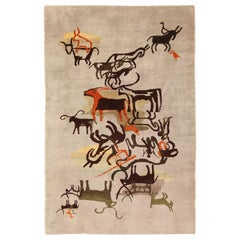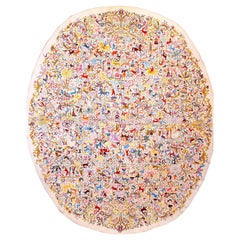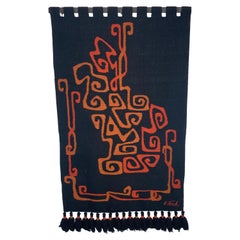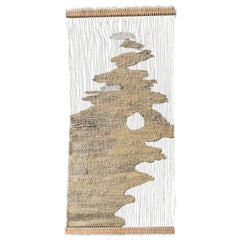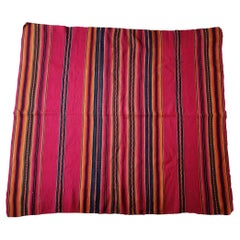Ecuadorean Furniture
3
2
to
1
3
5
4
5
1
1
3
2
3
1
1
5
5
1
1
5
5
52
34
20
5
1
Place of Origin: Ecuadorean
Creator: Olga Fisch
Tres Pescados By Paula Barragán
By Olga Fisch
Located in Quito, EC
Crafted from 100% Ecuadorian sheep wool, the Tres Pescados Tapestry is a testament to traditional artistry. Handwoven and meticulously dyed with colorfast pigments, each piece is a u...
Category
Early 2000s Ecuadorean Furniture
Materials
Silver
Frutas Tapestry By Paula Barragán
By Olga Fisch
Located in Quito, EC
Crafted from 100% Ecuadorian sheep wool, the Frutas Tapestry is a testament to traditional artistry. Handwoven and meticulously dyed with colorfast pigments, each piece is a unique e...
Category
2010s Ecuadorean Furniture
Materials
Wool
Vintage Olga Fisch Ecuadorian Rug. Size: 6' 10" x 10' 4"
By Olga Fisch
Located in New York, NY
Stunning vintage Ecuadorian rug by Olga Fisch, origin: Ecuador, circa mid-20th century. Size: 6 ft 10 in x 10 ft 4 in (2.08 m x 3.15 m)
Olga Fisch was an inspired artist of the mid-...
Category
Mid-20th Century Art Deco Ecuadorean Furniture
Materials
Wool
Mid 20th Century Ecuadorian Carpet ByOlga Fisch ( 11' x 13'4"-335 x 406 )
By Olga Fisch
Located in New York, NY
Ecuadorian carpet designed by Olga Fisch 13'4" x 11'0"
Of Hungarian origin, Olga Fisch (1901-1991) emigrated in 1933, first to Morocco and in 1939 to Ecuador, ahead of the political instability wracking Europe.
Already an artist and collector of folk art, Fisch quickly took to the local arts and crafts available
in the Quito markets. Folk and Paleolithic cave art and
established a workshop creating knotted pile carpets to her individualistic and unique designs.
The firm continues today, as does the museum of (primarily) Ecuadorian folk art. Only domestic
sheep wool is employed and the rugs are firmly symmetrically (Turkish) knotted on a cotton
foundation at a density of 60,000 knots per square meter or about 40 knots per square inch.
is a rare oval creation with the “Cabalito” pattern inspired by the folk embroidery on the “danzantes’ participants in the Corpus Christi processions from Cotopaxi, Ecuador. A number of these costumes are in the Olga Fisch Folk Art Museum in Quito. The pattern densely fills the ivory field with mobile figures, horses and vegetal motives. It is reminiscent of certain Greek Island women’s costume embroideries. Often the “Cabalito” pattern occupies an oval or lobed section on an otherwise plain rectangular carpet, but here is the pattern takes up almost all of the oval, with its energetic filigree of figures, fauna and flora.
Olga Fisch carpets are as 1950s modern as they get and our examples cry out for the right Danish or Swedish modern furniture as their perfect accompaniments. Some Italian Murano glass table objects won’t hurt either.
A Neutra or Schindler house in the Los Angeles hills is definitely the perfect context,
but any midcentury ranch...
Category
1950s Vintage Ecuadorean Furniture
Materials
Wool
Modernist Abstract Ecuadorian Tapestry / Wall Hanging Designed by Olga Fisch
By Olga Fisch
Located in Buffalo, NY
Stunning Modernist Abstract Ecuadorian Tapestry / wall hanging designed by Olga Fisch....
Of Hungarian origin, Olga Fisch (1901-1991) emigrated in...
Category
1960s Mid-Century Modern Vintage Ecuadorean Furniture
Materials
Wool
Related Items
2 Tapistries by Simone Prouve
By Simone Prouvé
Located in Long Island City, NY
Cotton, wool and mix-media. Both signed.
Simone Prouve (born 1931) is the daughter Jean Prouve.
Dimensions: H 93’´x W 62’´ and H 93’´x W43" for the rope ...
Category
1970s Mid-Century Modern Vintage Ecuadorean Furniture
Materials
Wool, Cotton, Rope
Vintage Andean Peruvian Fine Large Manta Cloth South American Textiles Decor
Located in London, GB
Vintage Andean Peruvian Manta Cloth South American Vintage Textiles.
A very fine Vintage Manta cloth from the High Andes region of Peru Woven in came-lid fibre (Llama wool )beautiful...
Category
1960s Vintage Ecuadorean Furniture
Materials
Wool, Cotton
Free Shipping
H 42.52 in W 45.28 in D 0.4 in
Mid-20th Century Handmade American Rag Rug
Located in New York, NY
A vintage American rag rug handmade during the mid-20th century.
Measures: 3' 6" x 5' 8"
North American rugs & carpets:
North American has never developed a unified handmade rug tradition, but rather it is the unassimilated confluence of several. From Mexico comes the Saltillo serape wearing blanket, and this stimulates the Navajo and Rio Grande (Colorado) weavers, first as blankets, then as rugs. The thrifty habits of rural America gave rise to the New England (and Western Canadian) hooked rug types, while the farmers of the Midwest recycled their disused garments into braided and rag rugs.
The closest to a real ongoing tradition are the Southwestern (New Mexican) Navajo rugs. By the 1860s the native tribes were weaving wearing blankets with wool from the Spanish churro sheep. These were in stripe design, with combinations of undyed wool with cochineal reds and indigo blues. The multi-phase “Chief’s Blankets” from the 1870s-80s are a natural outgrowth of these. Machine spun red wool from Germantown in Pennsylvania appeared in the 1870s with a bright red hitherto unobtainable. The weavers loved it and blankets appeared with bright reds, generally aniline, in “eye dazzler” patterns. Anglo traders established posts beginning in the 1890s. Navajo weavings were perfect accompaniments not only for Western-themed decors, but for East Coast apartments, only they needed to be thicker and more rug like to be truly accepted. The traders brought Caucasian and Turkish village rugs to copy, borders were introduced and central medallions devised. The weavers continued to create on vertical looms, with a shared warp (dovetailing) weft structure to avoid slits. The warps were cotton string. Sizes were generally scatters, but occasionally a special order came in, hence antique room size Navajos are very rare and very pricey. Distinct village/pueblo styles developed. Among the best are: Two Grey Hills (considered the tightest, closest of all Navajo weaving), Crystal Springs, and Ganado. Certain new patterns such as the “Storm pattern” with jagged lightning bolts emanating from a dark cloud developed. The Yei rug with dancing Kachina doll figures became popular. The palette has been expanded beyond the classic grey, tan, dark brown, and cream natural wool combination to again include reds, blues, and greens. Navajo pictorials include American flags, trains, and automobiles, domestic and local scenes and scenery. Individual artist weavers now command gallery shows and correspondingly elevated prices. There are several levels of Navajo work, and antique and vintage scatters with simple flat designs, medium weaves, and tritonal palettes, and in good floor worthy condition are still available reasonably.
The Native American weaving tradition extends into Colorado with two-piece scatters with sharp sawtooth medallions and striped end borders, with wool tapestry weave on cotton warps. These descend from the Saltillo blankets...
Category
Mid-20th Century Folk Art Ecuadorean Furniture
Materials
Wool, Cotton, Yarn
Antique French Tapestry Antique Tapestry Handmade Tapestry Verdure Tapestry
Located in New York, NY
Rare Antique French Tapestry handmade Verdure Tapestry
4' x 5'
122cm x 153cm
Circa 1920
A magnificent antique French tapestry depicting a hunting scene amongst a verdure s...
Category
1920s Vintage Ecuadorean Furniture
Materials
Wool
H 60.24 in W 48.04 in D 0.48 in
Mid-20th Century Handmade American Folk Rag Rug
Located in New York, NY
A vintage American folk rag rug in accent rug format handmade during the mid-20th century.
Measures: 5' 10" x 8' 7".
Category
Mid-20th Century Folk Art Ecuadorean Furniture
Materials
Wool
Vintage Folk Art Ecuadorian Tapestry with Olga Fisch Style
By Olga Fisch
Located in Dallas, TX
78310 Vintage Folk Art Ecuadorian tapestry with olga Fisch style, 01'11 x 02'09
Category
Late 20th Century Folk Art Ecuadorean Furniture
Materials
Wool
Mid-20th Century Handmade American Braided Round / Circular Accent Carpet
Located in New York, NY
A vintage American Braid round/circular accent rug handmade during the mid-20th century.
Measures: 7' 1" x 7' 1".
Category
Mid-20th Century American Classical Ecuadorean Furniture
Materials
Wool, Yarn
Oval Mid-20th Century Handmade American Braided Room Size Carpet
Located in New York, NY
A vintage American Braided oval room size carpet handmade during the mid-20th century.
Measures: 9' 5" x 12' 3"
North American has never developed a unified handmade rug tradition, but rather it is the unassimilated confluence of several. From Mexico comes the Saltillo serape wearing blanket, and this stimulates the Navajo and Rio Grande (Colorado) weavers, first as blankets, then as rugs. The thrifty habits of rural America gave rise to the New England (and Western Canadian) hooked rug types, while the farmers of the Midwest recycled their disused garments into braided and rag rugs.
The closest to a real ongoing tradition are the Southwestern (New Mexican) Navajo rugs. By the 1860’s the native tribes were weaving wearing blankets with wool from the Spanish churro sheep. These were in stripe design, with combinations of undyed wool with cochineal reds and indigo blues. The multi-phase “Chief’s Blankets” from the 1870’s-80’s are a natural outgrowth of these. Machine spun red wool from Germantown in Pennsylvania appeared in the 1870’s with a bright red hitherto unobtainable. The weavers loved it and blankets appeared with bright reds, generally aniline, in “eye dazzler” patterns. Anglo traders established posts beginning in the 1890’s. Navajo weavings were perfect accompaniments not only for Western-themed decors, but for East Coast apartments, only they needed to be thicker and more rug like to be truly accepted. The traders brought Caucasian and Turkish village rugs to copy, borders were introduced and central medallions devised. The weavers continued to create on vertical looms, with a shared warp (dovetailing) weft structure to avoid slits. The warps were cotton string. Sizes were generally scatters, but occasionally a special order came in, hence antique room size Navajos are very rare and very pricey. Distinct village/pueblo styles developed. Among the best are: Two Grey Hills (considered the tightest, closest of all Navajo weaving), Crystal Springs and Ganado. Certain new patterns such as the “Storm pattern” with jagged lightning bolts emanating from a dark cloud developed. The Yei rug with dancing Kachina doll figures became popular. The palette has been expanded beyond the classic grey, tan, dark brown and cream natural wool combination to again include reds, blue and greens. Navajo pictorials include: American flags, trains and automobiles, domestic and local scenes and scenery. Individual artist weavers now command gallery shows and correspondingly elevated prices. There are several levels of Navajo work, and antique and vintage scatters with simple flat designs, medium weaves and tritonal palettes, and in good floor worthy condition are still available reasonably.
The Native American weaving tradition extends into Colorado with two piece scatters with sharp sawtooth medallions and striped end borders, with wool tapestry weave on cotton warps. These descend from the Saltillo blankets...
Category
Mid-20th Century American Classical Ecuadorean Furniture
Materials
Wool, Yarn
Design Lips by Verner Panton
By Verner Panton
Located in Milan, IT
'Design Lips' is a fabric wall panel designed and produced in 1968 as part of Verner Panton's 'Anatomical Designs Collection', which were photoreali...
Category
1960s Space Age Vintage Ecuadorean Furniture
Materials
Cotton
Mid-Century, hand-woven Salasaca tapestry
By Olga Fisch
Located in Los Angeles, CA
Woven wool tapestry with primitive design made from Ecuador. This Salasaca piece, named after the small Equadorian town known for its exquisite tapestries, is part of a long standing...
Category
1970s Mid-Century Modern Vintage Ecuadorean Furniture
Materials
Wool
Early 20th Century Navajo Rug
Located in Chicago, IL
A striking early 20th century Navajo blanket with a bold all-over diamond pattern woven in crimson, white, gray, and black wool.
Category
1940s Navajo Vintage Ecuadorean Furniture
Materials
Wool
George Edouard Tremblay Folk Art Hooked Rug, Mat or Tapestry of a Winter Scene
Located in Hamilton, Ontario
This framed hooked rug or mat was done by the well known George Edouard Tremblay of Quebec Canada in approximately 1940 in his period Folk Art style. The rug or mat is done with wool...
Category
Mid-20th Century Folk Art Ecuadorean Furniture
Materials
Wool, Burlap, Pine
Previously Available Items
Olga Fisch "Casitas" Tapestry
By Olga Fisch
Located in Hanover, MA
1960's Olga Fisch tapestry called "Casitas" woven for Folklore.
Woven with Salasaca wool by the Salasaca Andean people and embellished with hammer...
Category
1960s Folk Art Vintage Ecuadorean Furniture
Materials
Brass
Ecuadorian "Caverna" Carpet by Olga Fisch - Room Size 12'x9'
By Olga Fisch
Located in Rochester, NY
Modernist Ecuadorian "Carverna" series hand knotted woven wool rug by Olga Fisch (Hungarian born, 1901 - 1990) inspired by the Magdalenian ice age Lascaux cave paintings discovered a...
Category
Mid-20th Century Mid-Century Modern Ecuadorean Furniture
Materials
Wool
Vintage Handmade 'Caballito' Folklore Rug by Olga Fisch, Ecuador, circa 1950s
By Olga Fisch
Located in San Antonio, TX
This handmade folklore rug by Olga Fisch is in overall excellent condition. Caballito pattern. Signed. Retains original label,
circa 1950s. Ecuador.
Dim...
Category
1950s Mid-Century Modern Vintage Ecuadorean Furniture
Materials
Wool
Ecuadorian Carpets Designed by Olga Fisch 12'0" x 16'0"
By Olga Fisch
Located in New York, NY
Of Hungarian origin, Olga Fisch (1901-1991) emigrated in 1933, first to Morocco and in 1939 to Ecuador, head of the political instability wracking Europe. Already an artist and collector of Folk Art, Fisch quickly took to the local arts and crafts available in the Quito markets. Folk and Paleolithic cave art and established a workshop creating knotted pile carpets to her individualistic and unique designs. The firm continues today, as does the museum of (primarily) Ecuadorian Folk Art. Only domestic sheep wool is employed and the rugs are firmly symmetrically (Turkish) knotted on a cotton foundation at a density of 60,000 knots per square meter or about 40 knots per square inch. It takes four weavers about six weeks to complete a 9’ by 12’ carpet.
Our two carpets, both from the 1950s, are in her most popular and iconic-patterns. Number 21953 (12’ by 16)’ in the “Caverna” pattern, displays, on an ivory ground, and without borders, an agitated congeries of stick figures of hunters and prey, primarily deer, adapted from the Paleolithic cave paintings of Lascaux, discovered in 1940 and incredibly influential in mid-century art. Whereas most examples are in the 9’ by 12’ or 10’ by 13’ formats, this is certainly one of the largest renderings of the pattern. The increased size allows the larger hunters and animals free movement, and increases the impact of the individual figures. Small variants were also woven, with only a few animals, also on a beige ground.
Our other carpet, number 21802 (11.0 x 13.4) is a rare oval creation with the “Cabalito” pattern inspired by the folk embroidery on the “danzantes’ participants in the Corpus Christi processions from Cotopaxi, Ecuador. A number of these costumes are in the Olga Fisch Folk Art Museum in Quito. The pattern densely fills the ivory field with mobile figures, horses and vegetal motives. It is reminiscent of certain Greek Island women’s costume embroideries. Often the “Cabalito” pattern occupies an oval or lobed section on an otherwise plain rectangular carpet, but here is the pattern takes up almost all of the oval, with its energetic filigree of figures, fauna and flora.
Other popular Olga Fisch patterns include the “Churos” design with angular discrete spirals on a subtly tones beige ground, a study in midcentury...
Category
1950s Art Nouveau Vintage Ecuadorean Furniture
Materials
Wool
Vintage Fiber Art by Olga Fisch for Folklore
By Olga Fisch
Located in Denton, TX
Large midcentury wool Tapestry by Olga Fisch for Folklore with metal ceramic beads woven in.
Category
20th Century Mid-Century Modern Ecuadorean Furniture
Materials
Metal
Vintage Ecuadorian Rug
By Olga Fisch
Located in New York, NY
An Ecuadorian rug designed by Olga Fisch in the mid-20th century. Signed lower right corner. Hungarian born designer Olga Fisch linked the gap between ...
Category
Mid-20th Century Mid-Century Modern Ecuadorean Furniture
Materials
Wool
Art Deco Ecuadorian Rug by Olga Fisch
By Olga Fisch
Located in New York, NY
Olga Fisch nee Anhalzer (1901-1990) was an extraordinary artist, art dealer and cultural advocate. Born in Hungary, Olga Fisch traveled the world exploring the jungles of South Ameri...
Category
Mid-20th Century Ecuadorean Furniture
Materials
Wool
Modernist Ecuadorian Rug by Olga Fisch from the "Caverna" Series
By Olga Fisch
Located in Buffalo, NY
Olga Fisch Rugs and Carpets - Olga Fisch nee Anhalzer (1901-1990) was an extraordinary artist, art dealer and cultural advocate. Born in Hungary, Olga Fisch traveled the world explor...
Category
Mid-20th Century Mid-Century Modern Ecuadorean Furniture
Materials
Wool
Olga Fisch Carpet "Caceria" Hungary Ecuador C.1950 12' x 9'
By Olga Fisch
Located in Chicago, IL
A large rug 12' x 9' "Cacerie" ('The Hunt") designed by the Hungarian immigree Olga Fisch and hand woven c.1950 in her Ecuador studio by local artisans. These colorful rugs were an i...
Category
1940s Mid-Century Modern Vintage Ecuadorean Furniture
Recently Viewed
View AllMore Ways To Browse
Brass And Glass Display Shelves
Chain Knot
Painted Commode Antique
Bow Chest Of Drawers
Brass Antique Door Hinges
Wooden Front Doors
Burl Chest With Drawers
Art Nouveau Dealers
Bronze Display Case
Bright White 1960s
Blue Painted Furniture Chest
Walnut Double Door
Century Furniture Hutch
Upholstered Case Pieces
Wood Box With Drawers
Antique French Marble Chest Of Drawers
Brass Hardware Cabinet Pull
Blue Commode
